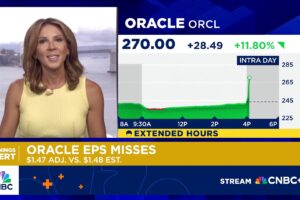
Nvidia dominates the artificial intelligence chip market, but the company is not invincible.
Nvidia (NVDA 1.51%) shares have surged 145% over the past year due to the semiconductor company’s critical position in the artificial intelligence (AI) economy. Specifically, Nvidia graphics processing units (GPUS) are the industry standard in accelerating complex data center workloads like training machine learning models and running artificial intelligence applications.
Earlier this year, The Wall Street Journal reported, “Nvidia’s chips underpin all of the most advanced AI systems, giving the company a market share estimated at more than 80%.” Some analysts believe Nvidia controls as much as 95% of the AI chip market. But Amazon (AMZN 3.71%) recently issued a warning for Nvidia shareholders.
Amazon CEO Andy Jassy’s warning to Nvidia shareholders
Amazon CEO Andy Jassy recently told analysts no single artificial intelligence chip will fit every use case, simply because companies and developers want optionality. “You saw this several years ago when some companies tried to argue that TensorFlow will be the only machine learning framework that mattered, and then PyTorch and others overtook it,” Jassy explained.
Nvidia consistently sets performance records at the MLPerf benchmarks, objective tests that measure how well AI systems perform training and inference tasks. But Nvidia graphics processing units (GPUs) are also very expensive. Its H200 GPUs cost up to $40,000 each, and full server racks cost millions of dollars. Jassy believes there is robust demand for products between the two extremes, so Amazon is developing custom AI silicon.
“We have a deep partnership with Nvidia and the broadest selection of Nvidia instances available, but we’ve heard loud and clear from customers that they relish better price performance,” Jassy told analysts. “It’s why we’ve invested in our own custom silicon. Trainium for training and Inferentia for inference.”
Importantly, Amazon has previous experience in developing custom chips. The company has been designing generalized central processing units (CPUs) called Graviton processors for several years. Those chips are based on Arm architecture, and they offer 30% to 40% better price performance versus the leading x86 processors from AMD and Intel, according to Jassy.
Amazon has the same goal with its custom AI silicon. Trainium and Inferentia are not meant to challenge Nvidia GPUs on performance alone, but rather to provide customers with a cost-efficient alternative. Some companies would rather pay a premium for the fastest AI chips, but others would gladly use slower chips to save money.
Morgan Stanley believes custom silicon will become increasingly popular
Amazon is not the only company that is designing custom silicon. Broadcom develops custom AI chips for Alphabet‘s Google and Meta Platforms, and it won a third major customer earlier this year. The company has not named the customer, but Reuters identified it as TikTok parent ByteDance. Additionally, J.P. Morgan analysts recently speculated that Broadcom has also secured a contract to build custom AI chips for OpenAI, bringing its total to four major customers.
Joseph Moore at Morgan Stanley expects that trend to continue. “Hyperscalers, including Amazon, Google, and Meta, use custom silicon for their data centers due to cost and energy constraints in AI computing. As hyperscalers continue to invest in AI infrastructure, we expect increased demand for energy-efficient and cost optimizing custom chips to outpace the growth of general-purpose GPUs,” he wrote in a note to clients.
Here’s the big picture: While Nvidia dominates the AI processor market today, input from Amazon and Morgan Stanley indicates the company is virtually guaranteed to lose market share in the years ahead. That does not mean Nvidia will lose its leadership position in the AI chip market. I doubt that will happen. But some spending will inevitably be redirected away from expensive Nvidia GPUs as more cost-efficient alternatives are made available.
Additionally, Nvidia will probably lose some pricing power as it fights to maintain its market share. Indeed, the company’s gross margin declined 330 basis points sequentially in the most recent quarter, despite reporting 122% revenue growth on strong demand for its AI chips. Investors should expect that trend to continue in the coming quarters.
However, Nvidia is not necessarily a bad investment. In fact, Wall Street still expects its earnings to increase at 37% annually over the next three years. That consensus estimate makes the current valuation of 56 times earnings look reasonable. Those figures give a PEG ratio of 1.5, which is well below the three-year average of 3.1.
Personally, I think investors looking to capitalize on the artificial intelligence boom should have a position in Nvidia, and I am not alone. A recent note from Jim Kelleher at Argus reads, “We believe that most technology investors should own [Nvidia] in the age of deep learning, AI, and GPU-driven application acceleration.”
John Mackey, former CEO of Whole Foods Market, an Amazon subsidiary, is a member of The Motley Fool’s board of directors. Suzanne Frey, an executive at Alphabet, is a member of The Motley Fool’s board of directors. JPMorgan Chase is an advertising partner of The Ascent, a Motley Fool company. Randi Zuckerberg, a former director of market development and spokeswoman for Facebook and sister to Meta Platforms CEO Mark Zuckerberg, is a member of The Motley Fool’s board of directors. Trevor Jennewine has positions in Amazon and Nvidia. The Motley Fool has positions in and recommends Advanced Micro Devices, Alphabet, Amazon, JPMorgan Chase, Meta Platforms, and Nvidia. The Motley Fool recommends Broadcom and Intel and recommends the following options: short November 2024 $24 calls on Intel. The Motley Fool has a disclosure policy.






